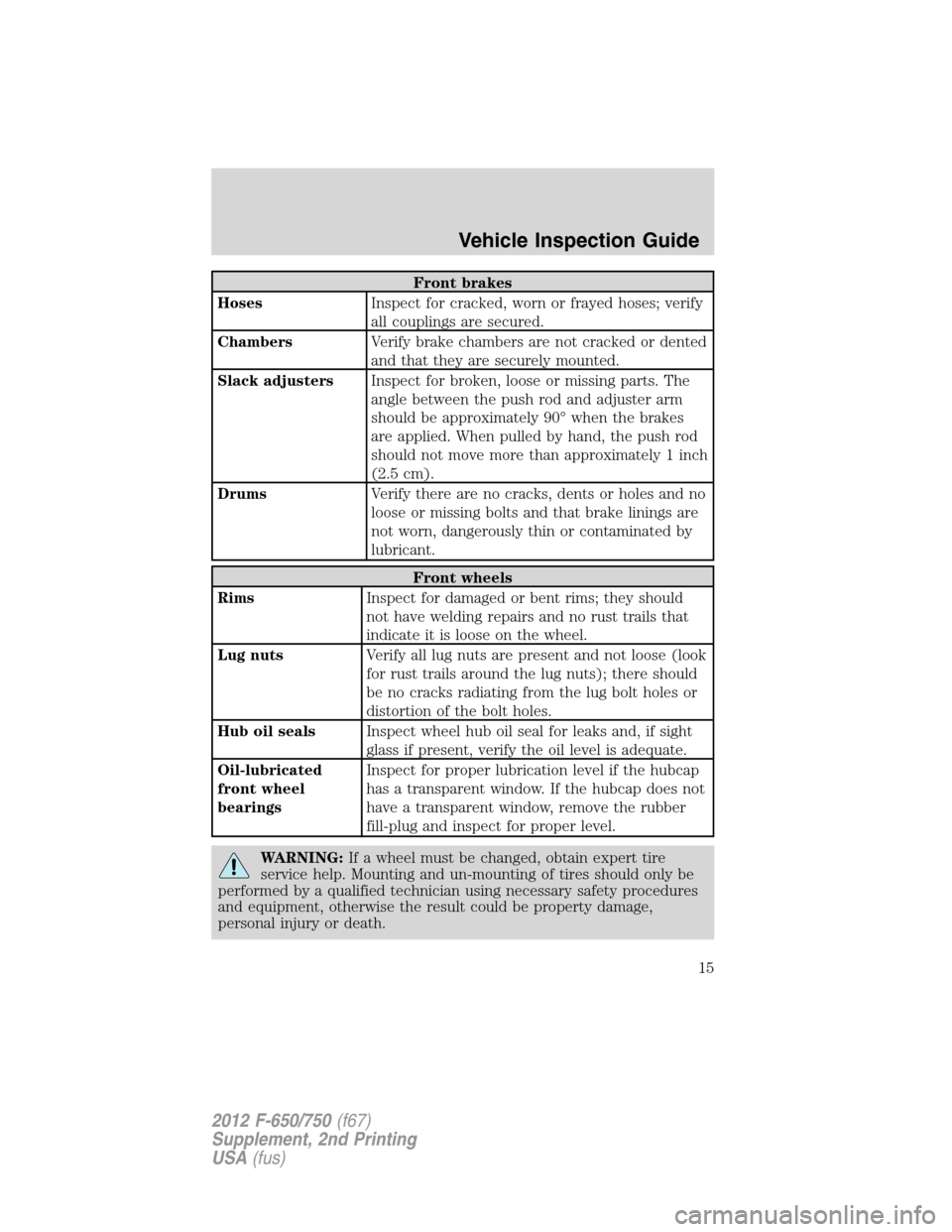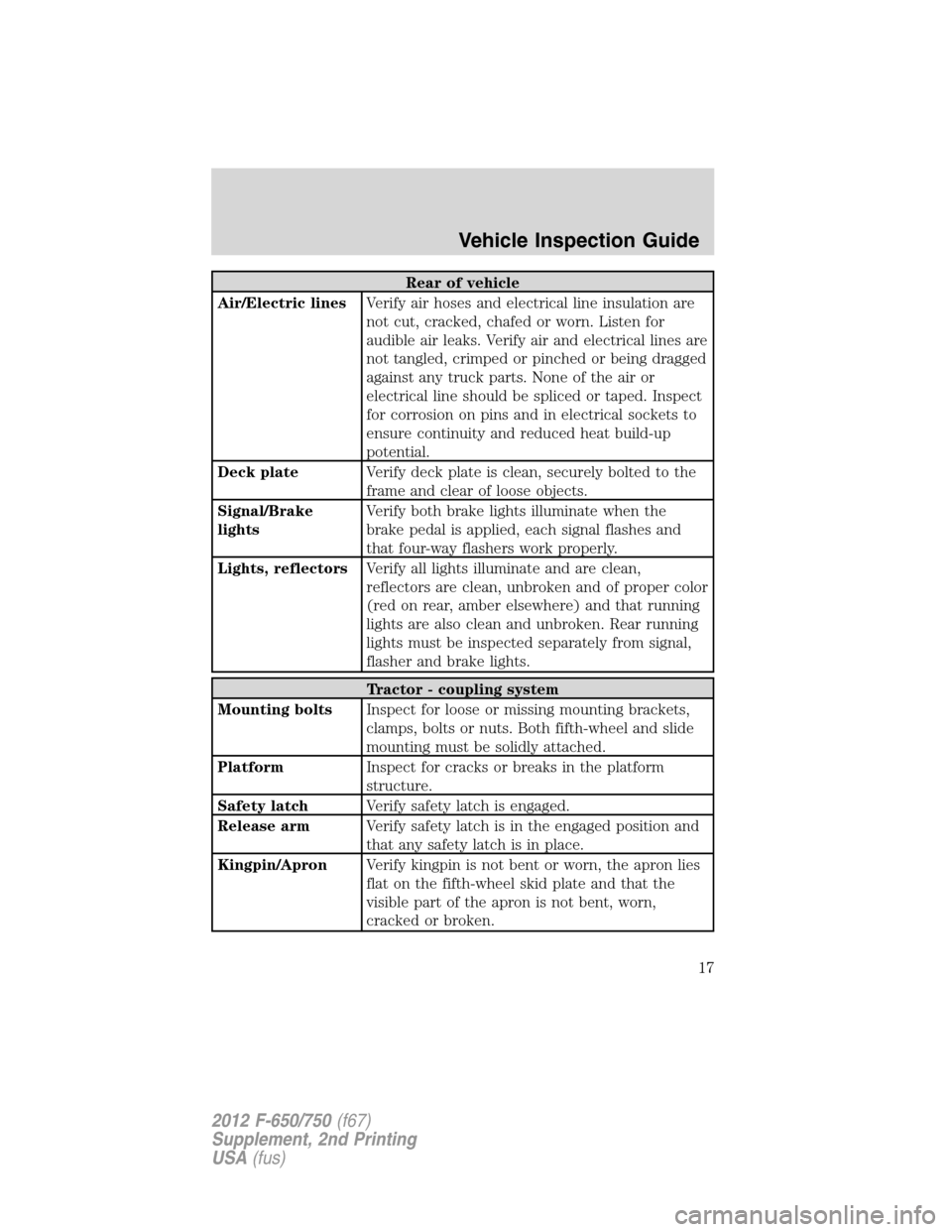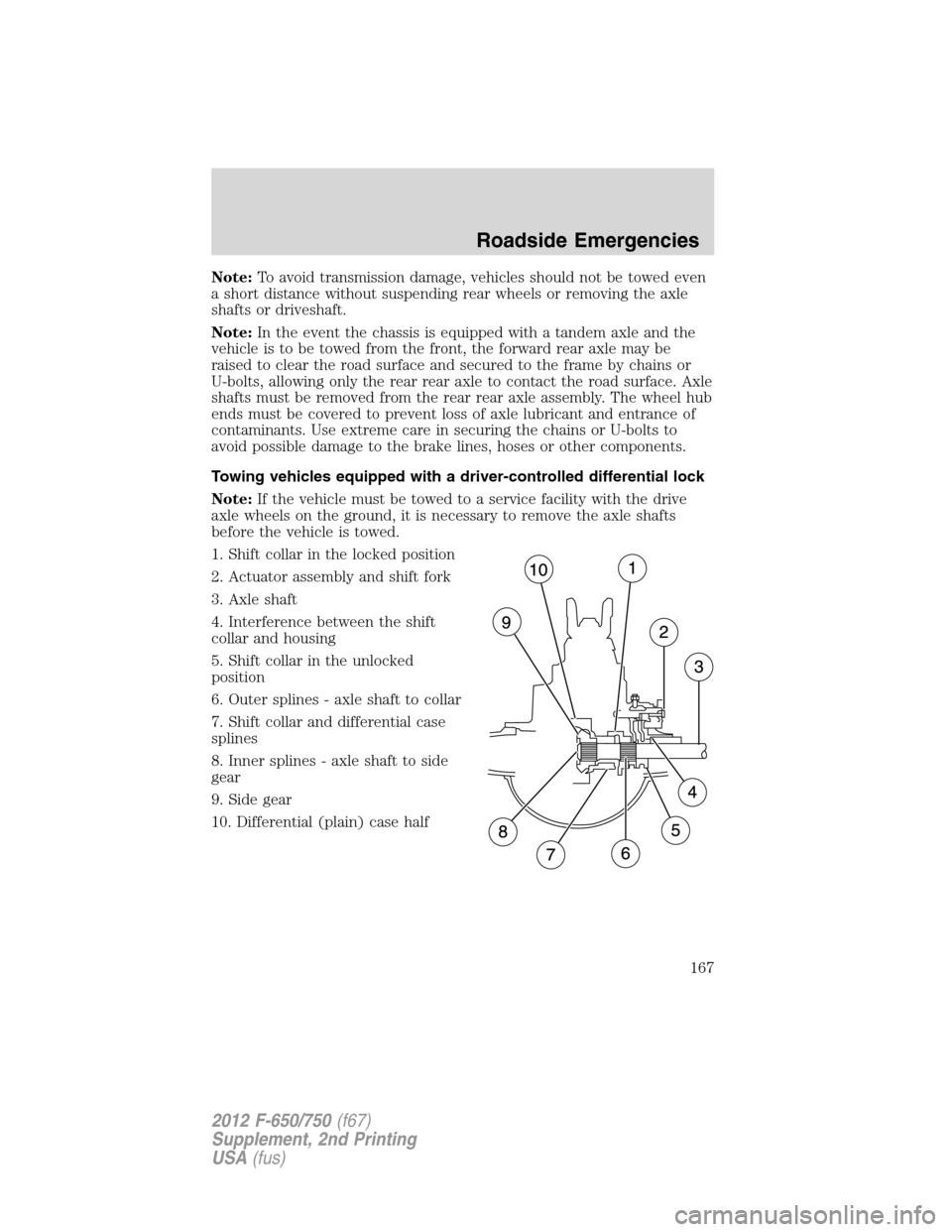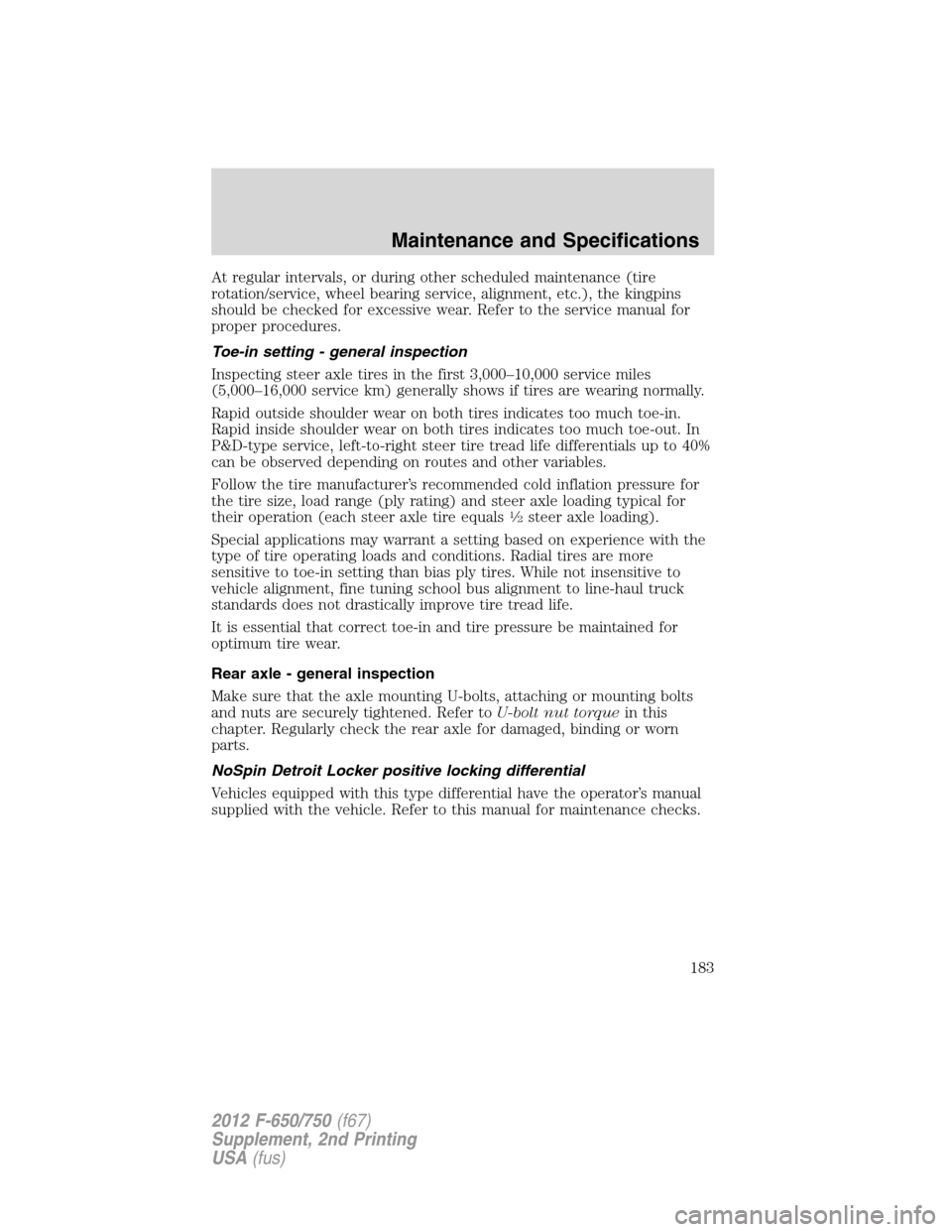2012 FORD F650 wheel bolts
[x] Cancel search: wheel boltsPage 15 of 306

Front brakes
HosesInspect for cracked, worn or frayed hoses; verify
all couplings are secured.
ChambersVerify brake chambers are not cracked or dented
and that they are securely mounted.
Slack adjustersInspect for broken, loose or missing parts. The
angle between the push rod and adjuster arm
should be approximately 90° when the brakes
are applied. When pulled by hand, the push rod
should not move more than approximately 1 inch
(2.5 cm).
DrumsVerify there are no cracks, dents or holes and no
loose or missing bolts and that brake linings are
not worn, dangerously thin or contaminated by
lubricant.
Front wheels
RimsInspect for damaged or bent rims; they should
not have welding repairs and no rust trails that
indicate it is loose on the wheel.
Lug nutsVerify all lug nuts are present and not loose (look
for rust trails around the lug nuts); there should
be no cracks radiating from the lug bolt holes or
distortion of the bolt holes.
Hub oil sealsInspect wheel hub oil seal for leaks and, if sight
glass if present, verify the oil level is adequate.
Oil-lubricated
front wheel
bearingsInspect for proper lubrication level if the hubcap
has a transparent window. If the hubcap does not
have a transparent window, remove the rubber
fill-plug and inspect for proper level.
WARNING:If a wheel must be changed, obtain expert tire
service help. Mounting and un-mounting of tires should only be
performed by a qualified technician using necessary safety procedures
and equipment, otherwise the result could be property damage,
personal injury or death.
Vehicle Inspection Guide
15
2012 F-650/750(f67)
Supplement, 2nd Printing
USA(fus)
Page 17 of 306

Rear of vehicle
Air/Electric linesVerify air hoses and electrical line insulation are
not cut, cracked, chafed or worn. Listen for
audible air leaks. Verify air and electrical lines are
not tangled, crimped or pinched or being dragged
against any truck parts. None of the air or
electrical line should be spliced or taped. Inspect
for corrosion on pins and in electrical sockets to
ensure continuity and reduced heat build-up
potential.
Deck plateVerify deck plate is clean, securely bolted to the
frame and clear of loose objects.
Signal/Brake
lightsVerify both brake lights illuminate when the
brake pedal is applied, each signal flashes and
that four-way flashers work properly.
Lights, reflectorsVerify all lights illuminate and are clean,
reflectors are clean, unbroken and of proper color
(red on rear, amber elsewhere) and that running
lights are also clean and unbroken. Rear running
lights must be inspected separately from signal,
flasher and brake lights.
Tractor - coupling system
Mounting boltsInspect for loose or missing mounting brackets,
clamps, bolts or nuts. Both fifth-wheel and slide
mounting must be solidly attached.
PlatformInspect for cracks or breaks in the platform
structure.
Safety latchVerify safety latch is engaged.
Release armVerify safety latch is in the engaged position and
that any safety latch is in place.
Kingpin/ApronVerify kingpin is not bent or worn, the apron lies
flat on the fifth-wheel skid plate and that the
visible part of the apron is not bent, worn,
cracked or broken.
Vehicle Inspection Guide
17
2012 F-650/750(f67)
Supplement, 2nd Printing
USA(fus)
Page 167 of 306

Note:To avoid transmission damage, vehicles should not be towed even
a short distance without suspending rear wheels or removing the axle
shafts or driveshaft.
Note:In the event the chassis is equipped with a tandem axle and the
vehicle is to be towed from the front, the forward rear axle may be
raised to clear the road surface and secured to the frame by chains or
U-bolts, allowing only the rear rear axle to contact the road surface. Axle
shafts must be removed from the rear rear axle assembly. The wheel hub
ends must be covered to prevent loss of axle lubricant and entrance of
contaminants. Use extreme care in securing the chains or U-bolts to
avoid possible damage to the brake lines, hoses or other components.
Towing vehicles equipped with a driver-controlled differential lock
Note:If the vehicle must be towed to a service facility with the drive
axle wheels on the ground, it is necessary to remove the axle shafts
before the vehicle is towed.
1. Shift collar in the locked position
2. Actuator assembly and shift fork
3. Axle shaft
4. Interference between the shift
collar and housing
5. Shift collar in the unlocked
position
6. Outer splines - axle shaft to collar
7. Shift collar and differential case
splines
8. Inner splines - axle shaft to side
gear
9. Side gear
10. Differential (plain) case half
Roadside Emergencies
167
2012 F-650/750(f67)
Supplement, 2nd Printing
USA(fus)
Page 183 of 306

At regular intervals, or during other scheduled maintenance (tire
rotation/service, wheel bearing service, alignment, etc.), the kingpins
should be checked for excessive wear. Refer to the service manual for
proper procedures.
Toe-in setting - general inspection
Inspecting steer axle tires in the first 3,000–10,000 service miles
(5,000–16,000 service km) generally shows if tires are wearing normally.
Rapid outside shoulder wear on both tires indicates too much toe-in.
Rapid inside shoulder wear on both tires indicates too much toe-out. In
P&D-type service, left-to-right steer tire tread life differentials up to 40%
can be observed depending on routes and other variables.
Follow the tire manufacturer’s recommended cold inflation pressure for
the tire size, load range (ply rating) and steer axle loading typical for
their operation (each steer axle tire equals
1�2steer axle loading).
Special applications may warrant a setting based on experience with the
type of tire operating loads and conditions. Radial tires are more
sensitive to toe-in setting than bias ply tires. While not insensitive to
vehicle alignment, fine tuning school bus alignment to line-haul truck
standards does not drastically improve tire tread life.
It is essential that correct toe-in and tire pressure be maintained for
optimum tire wear.
Rear axle - general inspection
Make sure that the axle mounting U-bolts, attaching or mounting bolts
and nuts are securely tightened. Refer toU-bolt nut torquein this
chapter. Regularly check the rear axle for damaged, binding or worn
parts.
NoSpin Detroit Locker positive locking differential
Vehicles equipped with this type differential have the operator’s manual
supplied with the vehicle. Refer to this manual for maintenance checks.
Maintenance and Specifications
183
2012 F-650/750(f67)
Supplement, 2nd Printing
USA(fus)
Page 266 of 306

Daily owner checks
U.S. Department
of Transportation,
Federal Highway
Administration
requirements
(ensure that the
entire system is
functioning
properly)Service brakes
Parking brake
Steering mechanism
Lighting devices and reflectors
Tires
Horn
Windshield wipers
Rear vision mirrors
Wheels and rims
Emergency equipment
Every oil change
EngineInspect engine cooling system hoses, clamps and
protection.*
Inspect drive belts.
Exhaust systemInspect entire exhaust system (including the inlet
pipe(s), muffler(s), outlet pipe(s), clamps and
fasteners) for holes, leakage, breakage, corrosive
damage and separation from other components.
Adjust, service or replace with the same or the
equivalent part. (Also a noise emission control
service.)
SuspensionTighten the front and rear spring U-bolts to the
specified torque.
Driveline and rear
axleLubricate the U-joints and the slip yoke.
Scheduled Maintenance Guide
266
2012 F-650/750(f67)
Supplement, 2nd Printing
USA(fus)